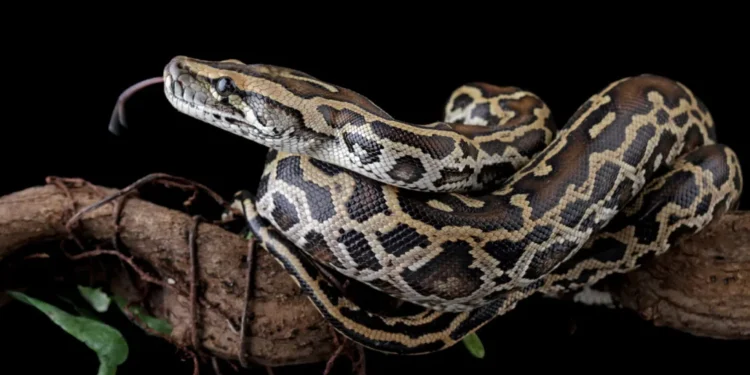Burmese pythons are infamous for their ability to swallow prey whole—fur, teeth, bones, and all. But what emerges from the other end is mysteriously devoid of hard material. Not a single bone fragment appears in their waste. The secret behind this biological magic? Newly discovered, iron-rich cells in their intestines that help manage the overload of minerals.
This breakthrough discovery was recently detailed in the July edition of the Journal of Experimental Biology by an international team of scientists led by ecophysiologist Jehan-Hervé Lignot from the University of Montpellier in France. These findings shed light on how pythons (and possibly other carnivorous reptiles) are able to safely process an otherwise dangerous influx of calcium and phosphorus from their bony meals.
Feast and Famine
Pythons are “intermittent feeders,” meaning they can go weeks or even months between meals. During fasting, their digestive system enters a dormant state: digestive juices stop flowing, intestinal linings shrink, and nutrient-absorbing microvilli wither. But once a meal arrives, such as a juicy rat, the entire system rapidly reactivates. Stomach acidity drops to pH 2, and microvilli regrow to maximize absorption.
Researchers wanted to understand how snakes manage such rapid and intense changes, especially when it comes to absorbing vital nutrients like calcium. Too little calcium can compromise their health, while too much can be toxic. It was a balancing act the researchers were eager to decode.
The Cellular Solution
In the experiment, 14 Burmese pythons were divided into different groups: fasting snakes, those fed with a whole rat, those fed with a deboned rat (low in calcium), and another group fed with deboned rats but supplemented with extra calcium. The study revealed a striking pattern.
In calcium-rich meals, scientists spotted cup-shaped cells in the pythons’ small intestines that appeared between nutrient-absorbing villi. These cells were filled with iron-rich particles, which functioned like microscopic scaffolding. Around these iron cores, layers of calcium and phosphorus formed, much like a snowflake accumulates ice around a dust particle. The end result? Bone-derived minerals safely packaged and excreted.
Electron microscope images of python feces showed them filled with these mineral-laden particles. “There’s a lot of calcium actually put away in the poo,” said Lignot. It’s an elegant waste management solution that allows pythons to digest bone while avoiding calcium toxicity.
Evolutionary Adaptation
According to conservation biologist Mike Cove of the North Carolina Museum of Natural Sciences, who was not involved in the study, this digestive strategy makes pythons remarkably adaptable. “No wonder they can literally digest anything,” he remarked. His team works on eradicating invasive Burmese pythons in the Florida Keys, where these snakes have devastated local wildlife.
He noted that many captured pythons contain nearly digested skeletons of their prey, including raccoons. In some cases, even tooth enamel was visibly eroded by the acidic stomach.
More Than Just Pythons
Lignot’s discovery may not be exclusive to pythons. The same type of iron-based mineral-managing cells has now been identified in boas, alligators, and Gila monsters. It’s likely that other reptiles like green water snakes and sunbeam snakes, which also swallow prey whole, share this trait.
Interestingly, this discovery may also have implications beyond reptiles. Birds, being close evolutionary relatives of reptiles, may exhibit similar traits. The bearded vulture (Gypaetus barbatus), for example, is known to consume bones. It stands as a potential candidate for future research into whether these bone-digesting cells appear in other vertebrates.
A Natural Engineering Marvel
This research not only unravels a mystery in snake biology but also illustrates how nature evolves highly specialized tools to manage extreme conditions. Pythons, by evolving these cup-shaped, mineral-compacting cells, ensure they get all the benefits of a bone-rich diet without the risks of mineral overload.
Understanding these biological processes could eventually inform biomedical and dietary research, particularly in areas of calcium metabolism and digestion.
As science continues to zoom in on the micro-mysteries of animal physiology, discoveries like these remind us how much we still have to learn from nature’s most unexpected sources—even snake poop.



